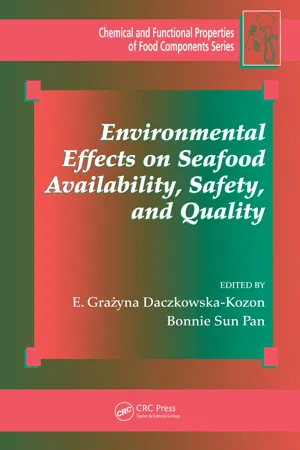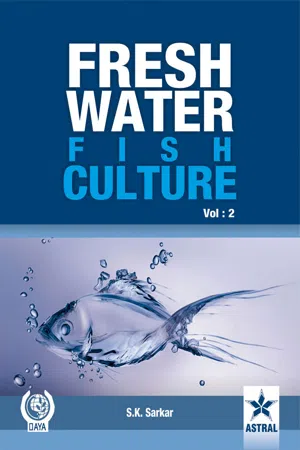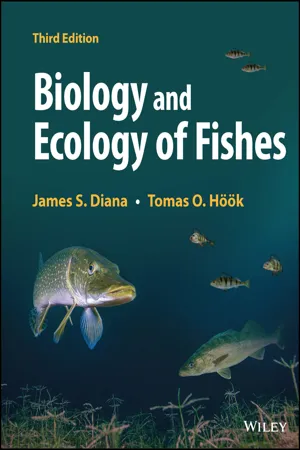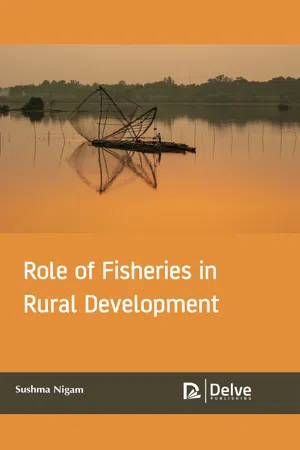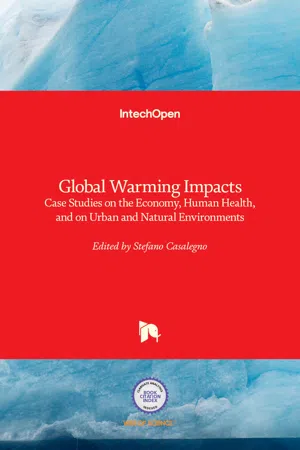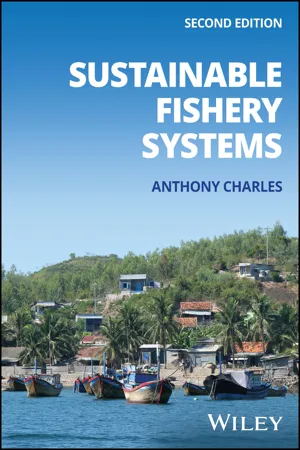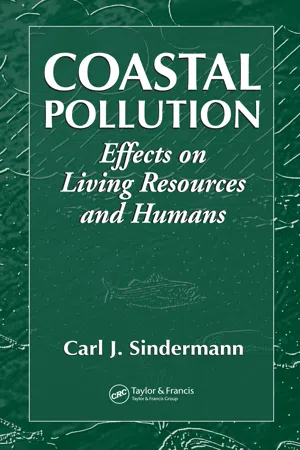Geography
Environmental Impact of Fishing
The environmental impact of fishing refers to the effects of fishing activities on the marine ecosystem. These impacts can include overfishing, bycatch of non-target species, habitat destruction, and pollution from fishing vessels. Overfishing can lead to declines in fish populations and disrupt the balance of marine ecosystems, while bycatch and habitat destruction can harm non-target species and their habitats.
Written by Perlego with AI-assistance
Related key terms
1 of 5
9 Key excerpts on "Environmental Impact of Fishing"
- E. Grazyna Daczkowska-Kozon, Bonnie Sun Pan(Authors)
- 2016(Publication Date)
- CRC Press(Publisher)
51 4.3.1 Effects of Environmental Factors ....................................................... 51 4.3.2 Effects of Fisheries Management ....................................................... 52 4.3.2.1 Fishing Gear ......................................................................... 53 4.3.2.2 Boat Size .............................................................................. 54 4.3.2.3 Fishing Areas ....................................................................... 54 4.3.2.4 Fishing Periods .................................................................... 54 4.3.2.5 In-Season Management ........................................................ 55 4.3.2.6 Number of Harvesters .......................................................... 55 References ................................................................................................................ 56 40 Environmental Effects on Seafood Availability, Safety, and Quality 4.2.1 E FFECTS OF E NVIRONMENTAL F ACTORS Environmental factors affect the availability of fishes in two ways: • Biological: Affecting the numbers of fish and the size of individuals. • Ecological: Affecting the distribution (location) of fish. To begin, here are definitions of three important terms: • Species: A group of organisms that can interbreed. • Population: A group of organisms of the same species, in a given area. • Stock: The portion of a population whose members are above a certain size or age: • Reproductive stock: Those members of a stock that have attained the age of sexual maturity. • Fishable stock: Those members of a stock that have grown large enough to be vulnerable to capture by fishing gear. Humans harvest fish from the fishable stock. The abundance of the fishable stock is determined by the dynamic rates of the population (Figure 4.1): • Additions: • Fecundity refers to the number of eggs that each female fish produces.- eBook - PDF
- Sarkar, S K(Authors)
- 2021(Publication Date)
- Daya Publishing House(Publisher)
5 Role of Environmental Factors in Relation to Fish Culture Fish interact ceaselessly on with their ecosystem in two ways. Firstly, they have certain environmental factors such as temperature, pH, light, salinity, oxygen, and some other factors that follow, which differ depending on fish growth. And secondly, fish have an impact on their surroundings and the biota is directly related to the excretory products, wastes, diseases, and parasites. The indirect effects on farmed fish include the infrastructure requirements of culture sites. These interactions may be linked, for example, when the ecosystem is not able to buffer culture-induced changes in the sediment or water quality which are then dangerous to fish themselves. The geographical factors that stimulate fish culture are of critical importance and are discussed elsewhere in Volume 1. The first section of the chapter therefore summarizes the general aspects of the geographical factors influencing the farmed fish. The second and third sections will cover environmental impacts on fish culture with respect to sources and effects of waste products from fish culture, chemical effects, impacts on wild fish and other animals and impact limitation strategies. 5.1 Geographical Factors Influencing Fish Culture The distribution of fish and farm activities are everywhere and they are greatly influenced by environmental factors. In some environments, fish farming is favoured by climate, soil, and water so that very little effort is needed to raise fish. In others, farmers are at the mercy of nature; and great skill is required to alter the environment to obtain minimal level of existence. The followings are some of the major factors that influence farmers and their activity. CLIMATE This ebook is exclusively for this university only. Cannot be resold/distributed. Climate is the general weather conditions prevailing in an area over a long period. - eBook - ePub
Oceans and Marine Resources in a Changing Climate
A Technical Input to the 2013 National Climate Assessment
- Roger Griffis, Jennifer Howard, Roger Griffis, Jennifer Howard(Authors)
- 2013(Publication Date)
- NCA Regional Input Reports(Publisher)
in marine resources due to climate change. This section identifies many of the important areas and directions of potential socio-economic effects, although, for the moment, not the details of those effects. The focus is on three approaches to exploring the impacts of climate change on human uses of the ocean. The first approach is to combine a baseline of current human uses of marine resources with case studies of currently documentable changes occurring in specific marine resources and their associated socio-economic impacts. Few of these case studies currently exist, but certain conclusions can be drawn from available data and information. The second approach is the construction of generally expected impacts given certain changes in specific marine resources and environments. Finally, the implications of these changes for marine resource governance systems will be explored. Will these changes necessitate new or different governance regimes or will they simply require adaptation of existing regimes, and, if so, what kinds of adaptation? Unfortunately, the research and literature on human uses of the ocean and ocean services is not uniform by region of the U.S.; however, an attempt was made to be comprehensive in our coverage of all areas of the U.S. EEZ, and substantial material and case studies for most regions has been included.4.2 Climate Effects on Capture FisheriesFishing is a production activity that takes place under uncommonly uncontrolled conditions. It follows that the output of fisheries, as well as their costs and net benefits, are directly and strongly affected by variations in natural conditions. We can do very little about these conditions but have to adjust to them as best we can. We are not in a position to warm up the ocean or change its salinity as would fit our interests. Neither can we change the ocean currents that affect the migrations of fish. Basically, in fisheries, unlike most other types of economic production, we … have to make do with what nature decides to make available..(Hannesson, 2007, page 157 )Commercial and recreational fisheries in the U.S. represent an annual multi-billion dollar industry (Tables 4-1 and 4-2 ). Subsistence fishing also contributes significantly to the health and well-being of fishing-dependent communities and local economies across the U.S. In the U.S., fisheries managed by the federal government are generally defined as fishing activities that take place between 3 and 200 nautical miles from the coastline. Nationwide, National Oceanic and Atmospheric Administration (NOAA) Fisheries oversees the management of 230 major fish stocks or stock complexes that comprise 90 percent of the nation’s commercial harvest. In addition, individual states retain management authority over fishing activities within 3, or in some cases up to 9, nautical miles of their coasts or in their inland waters such as Puget Sound or Chesapeake Bay. For a better understanding of regional fishery characteristics, refer to Appendix A - eBook - ePub
- James S. Diana, Tomas O. Höök(Authors)
- 2023(Publication Date)
- Wiley(Publisher)
Fisheries harvest has served as a major consumptive use of fish stocks over human history. Dramatic increases in capture fisheries occurred globally from the 1950s to 1990s, and many stocks now appear to be overexploited. Concerns regarding overexploitation are widespread and relevant to both marine and freshwater fisheries, as well as commercial, subsistence, and recreational fisheries. While fisheries harvest can lead to depletion of fish stocks, fisheries exploitation can have a variety of additional demographic, ecological, and evolutionary effects. Exploitation tends to lead to fish stocks dominated by small, young fish due to the size selectivity of fisheries harvest. The selective nature of fisheries can also lead to the evolution of fish stocks in terms of growth potential, maturation schedules, and behavior. Fishing activities and harvest can have impacts beyond the specific species targeted, by potentially altering habitat conditions and affecting non‐target species, either through mortality via bycatch or through modified ecological interactions and food web effects. Therefore, fisheries simultaneously constitute a key sector for feeding the global human population as well as perhaps the greatest single stressor facing many wild fish populations.Literature Cited
- Allan, J.D., R. Abell, Z. Hogan, et al. 2005. Overfishing of inland waters. Bioscience 55:1041–1051.
- Arlinghaus, R., S.J. Cooke, J. Lyman, et al. 2007. Understanding the complexity of catch‐and‐release in recreational fishing: An integrative synthesis of global knowledge from historical, ethical, social and biological perspectives. Reviews in Fishery Science 15:75–167.
- Arlinghaus, R., R. Tillner, and M. Bork. 2015. Explaining participation rates in recreational fishing across industrialized countries. Fisheries Management and Ecology 22:45–55.
- Conover, D.O., and S.B. Munch. 2002. Sustaining fisheries yields over evolutionary scales. Science 297: 94–96.
- Cooke, S.J., and I.G. Cowx. 2004. The role of recreational fishing in global fish crises. Bioscience 54:857–859.
- Cooke, S.J., and H.L. Schramm. 2007. Catch‐and‐release science and its application to conservation and management of recreational fisheries. Fisheries Management and Ecology 14:73–79.
- Cooke, S.J., P. Venturelli, W.M. Twardek, et al. 2021. Technological innovations in the recreational fishing sector: Implications for fisheries management and policy. Reviews in Fish Biology and Fisheries 31:253–288.
- Eigaard, O.R., P. Marchal, H. Gislason, and A.D. Rijnsdorp. 2014. Technological Development and Fisheries Management. Reviews in Fisheries Science & Aquaculture 22:156–174.
- FAO. 2020. The State of World Fisheries and Aquaculture 2020 . Sustainability in action. Rome. http://www.fao.org/3/ca9229en/CA9229EN.pdf
- Feiner, Z.S., S.C. Chong, C.T. Knight, et al. 2015. Rapidly shifting maturation schedules following reduced commercial harvest in a freshwater fish. Evolutionary Applications
- eBook - ePub
Ecosystem Services and Global Trade of Natural Resources
Ecology, Economics and Policies
- Thomas Koellner(Author)
- 2013(Publication Date)
- Routledge(Publisher)
et al 2006). We will discuss the effects of fishing and aquaculture at three different scales: fish populations, habitats, and marine ecosystems.Effects of Fishing and Aquaculture on Fish Populations
That fishing affects the size and structure of exploited populations is not news for fisheries managers, but it is gaining increasing public recognition. Three examples of impacts serve to illustrate the potential impacts of fishing on populations.First, in coastal and estuarine fisheries, there is a tendency to fish directly on the portion of the population that is spawning (the “spawning stock”). This is because spawners often concentrate in areas where it is easy to capture them. For example, overfishing may not be immediately recognized as such, particularly if the target species alters its behavior when its abundance declines. This phenomenon, termed aggregation or even hyper-aggregation (Rose and Kulka 1999 ), is thought to have occurred within the northwestern stocks of Atlantic cod (Gadus morhua), the so-called “northern cod” whose population collapsed spectacularly in 1992. In the late 1980s, fishing was particularly intense in the northern Newfoundland sectors; by 1990, with numbers severely down, cod began to aggregate in the southern end of their habitat (Figure 8.3 ). The hyper-aggregation gave the appearance of very high abundance; indeed, record catches were made in the southern sector (Rose et al. 2000 ). Thus, spawning aggregations persisted even when abundances dropped. Without the benefit of an understanding of the behavioral ecology of cod, fishers – and even some managers – did not believe the warnings of the fishery biologists, since the fishing was great up until the end. Unfortunately, this phenomenon has been repeated many times, e.g. with salmons.Figure 8.3 - eBook - PDF
- Sushma Nigam(Author)
- 2019(Publication Date)
- Delve Publishing(Publisher)
The topic socio-economic impacts captures the information about the roles in social structure and economic benefits of fisheries. The importance of social, economic and environmental context has been mentioned in this chapter at the end. 4.1. INTRODUCTION The fisheries sector is an important sector for the development of national economic development. It is through an important economic activity and also a strategic activity in most of the coastal regions of the world, since it plays an eye-catching role in some of the countries like Namibia, Iceland, Maldives and other small island developing states which are rich in fishery resources in comparison to their populations. There is no doubt in that in many countries, fish export is the major contributor to the earnings of foreign exchange. This sector is sometimes are ranked much higher than other agricultural commodities in terms of contribution. The major trade flow-taking place from south to north highlights the importance of this sector for trade balance of a number of developing countries. Figure 4.1: Iceland Export Treemap. Source: https://commons.wikimedia.org/wiki/File:Iceland_Export_Treemap. jpg Socio-Economic Impacts of Fisheries Development 79 Another source of the foreign exchange revenue from the marine fishery resources is the licensing fees of foreign fishing fleets. This kind of source is majorly used in the South Pacific and West African countries. The more noticeable and substantial contribution of the fisheries in the whole world is the supply of animal protein which is highly nutritious for the consumption of human and the employment and the income generation of some of the remote coastal areas. Approximately 17% of the animal protein which is supplied is derived from the fisheries in many developing countries. Asian region is the home of around two third of the world’s population. Ultimately, since the importance of the recreational fishing is increasing, it is now noticeable. - eBook - PDF
Global Warming Impacts
Case Studies on the Economy, Human Health, and on Urban and Natural Environments
- Stefano Casalegno(Author)
- 2011(Publication Date)
- IntechOpen(Publisher)
Part 1 Economic Impacts of Global Warming at Global and Local Scales 1 Global Warming and Its Economic Effects on the Anchovy Fishery and Tourism Sector in North-Western Spain M. Dolores Garza-Gil, M. Xosé Vázquez-Rodríguez, Albino Prada-Blanco and Manuel Varela-Lafuente University of Vigo Spain 1. Introduction In recent years much evidence has been gathered on climate change and its impact on different sectors and systems. Global warming is one of the main threats to sustainable development and, consequently, one of the most significant environmental challenges in the last decades affecting the economy, health and social welfare. It is necessary, therefore, to identify evidence of the impact of global warming on biodiversity and carry out an economic evaluation. In the specific case of marine ecosystems, changes in rainfall frequency and intensity, acidity, water temperature, wind, dissolved CO 2 and salinity, combined with anthropogenic nutrient and toxin contamination, can affect water quality both in coastal regions as well as in the open sea. All of this will consequently affect the productivity of the marine environment. And given that fishing is one of the economic activities which critically depend on natural conditions or characteristics, the influence of environmental changes on fishing is notably higher than that which might occur in other primary activities. Furthermore, climate has a vital impact on the tourism and recreation sector and, therefore, this sector will be affected by any changes in climate. In this chapter, we assess the possible economic effects (losses or gains) of global warming on some of the main economic activities in north-western Spain. The economy of this region specialises in products derived from fishing and aquaculture as well as tourism, among others (IGE – Galician Statistics Institute-, 2010), and both activities are extremely sensitive to environmental conditions. - eBook - PDF
- Anthony Charles(Author)
- 2023(Publication Date)
- Wiley(Publisher)
Pollution, environmental degradation, climate change impacts and natural and human-induced disasters add to the threats facing small-scale fishing communities. (p. xi) FAO (2015a) / FAO 1.5 -hhrhcterising Fishery Systems 21 1.5.2 Spatial Scale and Time Scale 1.5.2.1 Spatial Scales The spatial scale of a fishery system relates to its size, geographically and administratively. For example, the following are fishery systems of varying spatial scales: ✽ a small (coastal) community, together with its local fishery resources (e.g. the fish in a tropical coral reef, or the lobster off the coast of a New England fishing community, or fish in a lake or river) and the corresponding small-scale management system; ✽ larger-scale fishery systems, from a sub-national to a national level, typically organ- ised around formal jurisdictional boundaries, as would often be in place in many countries; ✽ regional fisheries, involving multiple nations, and corresponding fishery organisations, such as (1) the FAO’s Regional Fishery Bodies [e.g. the General Fisheries Commission for the Mediterranean, GFCM, and the Western Central Atlantic Fishery Commission, WECAFC (FAO 2021a)], and (2) structures of the European Union revolving around the Common Fisheries Policy (European Commission: https://ec.europa.eu/fisheries/ cfp_en). Perhaps the spatial extent of the fishery is already determined, based on historical, socio- cultural, administrative, or other considerations. Alternatively, if decisions about spatial scale are to be made, which spatial scale is to be preferred and what should be the appropri- ate boundaries of the fishery system? When is it best to focus on a small scale and when should we look at the fishery as a larger system? These are important questions, since the spatial scale at which the fishery system is examined will likely affect how interactions among fishery components and the dynamics of those components (discussed in each chapter) are addressed. - eBook - PDF
Coastal Pollution
Effects on Living Resources and Humans
- Carl J. Sindermann(Author)
- 2005(Publication Date)
- CRC Press(Publisher)
241 13 Economic Effects of Coastal Pollution: A Resource Perspective INTRODUCTION Thus far in this book, we have examined the effects of coastal pollution on individual marine animals, on fisheries resource populations, on aquaculture production, and on humans. With all this as background, it seems logical now to put a price tag on pollution of coastal/estuarine waters — to assess economic effects, especially from the perspective of fish and shellfish resources and human well-being. That kind of assessment can be performed with some degree of adequacy for short-term imme-diate impacts, such as those associated with oil spills, but longer-term effects, such as possible reductions in available living resources or rejection of seafood products because of fear of contamination, are more difficult to quantify. An attempt at economic evaluation is almost obligatory, though, because, to many people, trans-lation of biological or environmental findings into dollars and cents terms is a necessary prelude to any conclusions that might be reached about pollution effects — and to some of those same people, unless an economic effect can be clearly demonstrated, the issue is unimportant. The topic of economic impacts of coastal pollution can be introduced with two back-to-back vignettes about historical aspects of the problem. The first and most recent is called “Plight of the Hudson River Fisherman,” and the second “The Great Contaminated Fish Scare in Japan.” Plight of the Hudson River Fisherman The lower reaches of the Hudson River, just above the compressed insanity that is New York City, but still within the range of the tides, have for entire lifetimes been favorite hunting grounds for George Kundera and his friends — all members of a special breed of small-boat commercial fishermen. His town is near the shores of that much-abused waterway, and his prey varies with the changing seasons: shad, eels, striped bass, menhaden, clams, and assorted other species.
Index pages curate the most relevant extracts from our library of academic textbooks. They’ve been created using an in-house natural language model (NLM), each adding context and meaning to key research topics.
